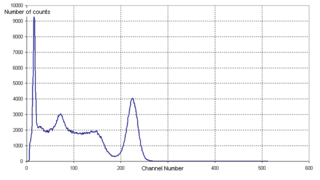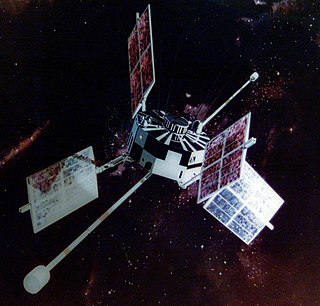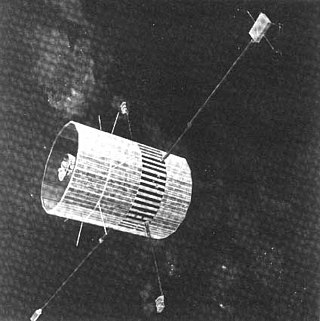Nuclear electronics is a subfield of electronics concerned with the design and use of high-speed electronic systems for nuclear physics and elementary particle physics research, and for industrial and medical use.
Essential elements of such systems include fast detectors for charged particles, discriminators for separating them by energy, counters for counting the pulses produced by individual particles, fast logic circuits (including coincidence and veto gates), for identification of particular types of complex particle events, and pulse height analyzers (PHAs) for sorting and counting gamma rays or particle interactions by energy, for spectral analysis.
Some of the essential components that make up the elements of a nuclear electronic analysis system include:
These elements were originally developed and built in the laboratories of the scientists doing the pioneering work in the field, but are nowadays designed, developed, and manufactured by a variety of specialized vendors:

A scintillation counter is an instrument for detecting and measuring ionizing radiation by using the excitation effect of incident radiation on a scintillating material, and detecting the resultant light pulses.
In physics and electrical engineering, a coincidence circuit or coincidence gate is an electronic device with one output and two inputs. The output activates only when the circuit receives signals within a time window accepted as at the same time and in parallel at both inputs. Coincidence circuits are widely used in particle detectors and in other areas of science and technology.
A wire chamber or multi-wire proportional chamber is a type of proportional counter that detects charged particles and photons and can give positional information on their trajectory, by tracking the trails of gaseous ionization.

HEAO-1 was an X-ray telescope launched in 1977. HEAO-1 surveyed the sky in the X-ray portion of the electromagnetic spectrum, providing nearly constant monitoring of X-ray sources near the ecliptic poles and more detailed studies of a number of objects by observations lasting 3–6 hours. It was the first of NASA's three High Energy Astronomy Observatories, HEAO 1, launched August 12, 1977 aboard an Atlas rocket with a Centaur upper stage, operated until 9 January 1979. During that time, it scanned the X-ray sky almost three times

The Nuclear Instrumentation Module (NIM) standard defines mechanical and electrical specifications for electronics modules used in experimental particle and nuclear physics. The concept of modules in electronic systems offers enormous advantages in flexibility, interchange of instruments, reduced design effort, ease in updating and maintaining the instruments.

Neutron detection is the effective detection of neutrons entering a well-positioned detector. There are two key aspects to effective neutron detection: hardware and software. Detection hardware refers to the kind of neutron detector used and to the electronics used in the detection setup. Further, the hardware setup also defines key experimental parameters, such as source-detector distance, solid angle and detector shielding. Detection software consists of analysis tools that perform tasks such as graphical analysis to measure the number and energies of neutrons striking the detector.

A constant fraction discriminator (CFD) is an electronic signal processing device, designed to mimic the mathematical operation of finding a maximum of a pulse by finding the zero of its slope. Some signals do not have a sharp maximum, but short rise times .
Electronic anticoincidence is a method widely used to suppress unwanted, "background" events in high energy physics, experimental particle physics, gamma-ray spectroscopy, gamma-ray astronomy, experimental nuclear physics, and related fields.

Time-of-flight mass spectrometry (TOFMS) is a method of mass spectrometry in which an ion's mass-to-charge ratio is determined by a time of flight measurement. Ions are accelerated by an electric field of known strength. This acceleration results in an ion having the same kinetic energy as any other ion that has the same charge. The velocity of the ion depends on the mass-to-charge ratio. The time that it subsequently takes for the ion to reach a detector at a known distance is measured. This time will depend on the velocity of the ion, and therefore is a measure of its mass-to-charge ratio. From this ratio and known experimental parameters, one can identify the ion.
A pulse-height analyzer (PHA) is an instrument that accepts electronic pulses of varying heights from particle and event detectors, digitizes the pulse heights, and saves the number of pulses of each height in registers or channels, thus recording a pulse-height spectrum or pulse-height distribution used for later pulse-height analysis. PHAs are used in nuclear- and elementary-particle physics research. A PHA is a specific modification to multichannel analyzers.

Explorer 18, also called IMP-A, IMP-1, Interplanetary Monitoring Platform-1 and S-74, was a NASA satellite launched as part of the Explorer program. Explorer 18 was launched on 27 November 1963 from Cape Canaveral Air Force Station (CCAFS), Florida, with a Thor-Delta C launch vehicle. Explorer 18 was the first satellite of the Interplanetary Monitoring Platform (IMP). Explorer 21 (IMP-B) launched in October 1964 and Explorer 28 (IMP-C) launched in May 1965 also used the same general spacecraft design.
The following outline is provided as an overview of and topical guide to electronics:

A radionuclide identification device is a small, lightweight, portable gamma-ray spectrometer used for the detection and identification of radioactive substances. It is available from many companies in various forms to provide hand-held gamma-ray radionuclide identification. Since these instruments are easily carried, they are suitable for first-line responders in key applications of Homeland Security, Environmental Monitoring and Radiological Mapping. These devices have also found their usefulness in medical and industrial applications as well as a number of unique applications such as geological surveys. In the past two decades RIIDs have addressed the growing demand for fast, accurate isotope identification. These light-weight instruments require room temperature detectors so they can be easily carried and perform meaningful measurements in various environments and locations.

A multichannel analyzer (MCA) is an instrument used in laboratory and field applications to analyze an input signal consisting of voltage pulses. MCAs are used extensively in digitizing various spectroscopy measurements, especially those related to nuclear physics, including various types of spectroscopy.

Explorer 28, also called IMP-C, IMP-3 and Interplanetary Monitoring Platform-3, was a NASA satellite launched on 29 May 1965 to study space physics, and was the third spacecraft launched in the Interplanetary Monitoring Platform program. It was powered by chemical batteries and solar panels. There were 7 experiments on board, all devoted to particle studies. Performance was normal until late April 1967, when intermittent problems began. It stayed in contact until 12 May 1967, when contact was lost. The orbit decayed until it re-entered the atmosphere on 4 July 1968. The spacecraft design was similar to its predecessors Explorer 18 (IMP-A), launched in November 1963, and Explorer 21 (IMP-B), launched in October 1964, though this satellite was a few kilograms lighter. The successor Explorer 33 (IMP-D) began the use of a new design.

Explorer 34, was a NASA satellite launched as part of Explorer program. Explorer 34 as launched on 24 May 1967 from Vandenberg Air Force Base, California, with Thor-Delta E1 launch vehicle. Explorer 34 was the fifth satellite launched as part of the Interplanetary Monitoring Platform program, but was known as "IMP-4" because the preceding launch was more specifically part of the "Anchored IMP" sub-program. The spacecraft was put into space between the launches of Explorer 33 in 1966 and Explorer 35 in July 1967, but the next satellite to use Explorer 34's general design was Explorer 41, which flew in 1969.

Explorer 41, also called as IMP-G and IMP-5, was a NASA satellite launched as part of Explorer program. Explorer 41 as launched on 21 June 1969 on Vandenberg AFB, California, with a Thor-Delta E1 launch vehicle. Explorer 41 was the seventh satellite launched as part of the overall Interplanetary Monitoring Platform series, though it received the post-launch designation "IMP-5" because two previous flights had used the "AIMP" designation instead. It was preceded by the second of those flights, Explorer 35, launched in July 1967. Its predecessor in the strict IMP series of launches was Explorer 34, launched in May 1967, which shared a similar design to Explorer 41. The next launch was of an IMP satellite was Explorer 43 in 1971.

Explorer 43, also called as IMP-I and IMP-6, was a NASA satellite launched as part of Explorer program. Explorer 43 was launched on 13 March 1971 from Cape Canaveral Air Force Station (CCAFS), with a Thor-Delta M6 launch vehicle. Explorer 43 was the sixth satellite of the Interplanetary Monitoring Platform.

Explorer 47, was a NASA satellite launched as part of Explorer program. Explorer 47 was launched on 23 September 1972 from Cape Canaveral, Florida, with a Thor-Delta 1604. Explorer 47 was the ninth overall launch of the Interplanetary Monitoring Platform series, but received the launch designation "IMP-7" because two previous "Anchored IMP" flights had used "AIMP" instead.
In particle physics, the coincidence method is an experimental design through which particle detectors register two or more simultaneous measurements of a particular event through different interaction channels. Detection can be made by sensing the primary particle and/or through the detection of secondary reaction products. Such a method is used to increase the sensitivity of an experiment to a specific particle interaction, reducing conflation with background interactions by creating more degrees of freedom by which the particle in question may interact. The first notable use of the coincidence method was conducted in 1924 by Walther Bothe and Hans Geiger.